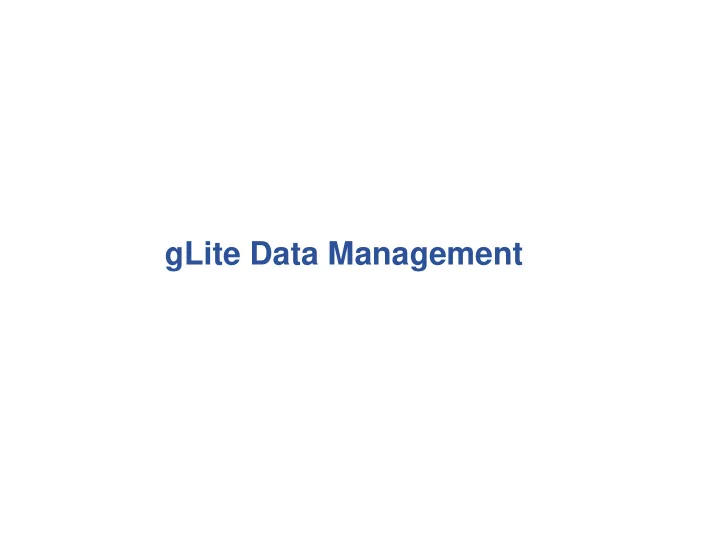

gLite Data Management
Agenda • gLite Data Management – Introduction – Examples – Name Convention – Storage Elements – LCG File Catalog • FTS Overview 2
Data Management System (DMS) • Provides file manipulation services for users and other Grid services. • DMS enables the location, access and transfer of data – User do not need to know data location, just the logical name – Data is accessed through standard interfaces – Data can be replicated or transferred to several locations as needed – Data is shared within a VO 3
Scope of data services in gLite • Simply, DMS provides all operation that all of us are used to performing Uploading /downloading files Creating file /directories Renaming file /directories Deleting file /directories Moving file /directories Listing directories Creating symbolic links • Note: Files are write-once, read-many – Files cannot be changed unless remove or replaced – No intention of providing a global file management system 4
Data Issues and Grid Solutions • Resource centers have growing demand for storage – Storage Element capable to manage multiple disk pools Disk Pool Manager (DPM), dCache, CASTOR • Data is stored on different storage systems technologies – Common interface required to hide underlying complexity Storage Resource Manager (SRM) – storage management protocol GridFTP – secure file transfer • Data is stored at different locations with separate namespace – File catalogue to provide uniform view of Grid data LCG File Catalog (LFC) • Applications need to access Grid data management services – Data management API GFAL 5
Data management example LCG FileCatalogue “User Input “sandbox” (LFC) DataSets info interface” Output “sandbox” Resource Broker Storage Storage Computing Element Element Element • File replicated onto 2 SEs 6
Data management example LCG FileCatalogue “User (LFC) “Myfile.dat” interface” File_on_se1 Myfile.dat guid File_on_se2 Storage Storage Element1 Element 2 • File replicated onto 2 SEs 7
Data management example LCG FileCatalogue “User (LFC) “Myfile.dat” interface” File_on_se1 (“SURL”: site URL) “GUID” Global Myfile.dat Unique Identifier “Logical filename” File_on_se2 (“SURL”: site URL) Storage Storage Element1 Element2 8
Name conventions • Logical File Name (LFN) – An alias created by a user to refer to some item of data, e.g. “lfn:/grid/cms / 20030203/run2/track1” • Globally Unique Identifier (GUID) – A non-human-readable unique identifier for an item of data, e.g. “guid:f81d4fae -7dec-11d0-a765- 00a0c91e6bf6” • Storage URL (SURL) or Physical File Name (PFN) – The location of an actual piece of data on a storage system, e.g. “srm://pcrd24.cern.ch/ flatfiles /cms/output10_1” (SRM) “sfn://lxshare0209.cern.ch/data/alice/ntuples.dat” (Classic SE) • Transport URL (TURL) – Temporary locator of a replica + access protocol: understood by a SE, e.g. “rfio://lxshare0209.cern.ch//data/alice/ntuples.dat” 9
Storage Element • Provides – Storage space for files – SRM Interface – Transfer protocol (gsiFTP) ~ GSI based FTP server – POSIX-like file access Accessed via Grid File Access Layer ( GFAL ) • API interface • To read parts of files too big to copy • Example is Disk Pool Manager (DPM) – Scalable management for independent disk pools for sites – Easy to install, configure and manage – Secure remote and local transfer protocols GridFTP, secure RFIO 10
LFC Service • LFC = LCG File Catalogue – LCG = LHC Compute Grid – LHC = Large Hadron Collider • Provides – Mapping between LFN, GUID and SURL – Transactions, Sessions, Bulk queries – Hierarchical namespace, symbolic links – System metadata – single string user metadata • All members of a given VO have read-write permissions in their directory • Commands look like UNIX with “lfc - ” in front (often) 11
LFC Continued • Users primarily access and manage files through “logical filenames” LFC has a directory tree structure /grid/<VO_name>/ <you create it> LFC Namespace Defined by the user •Mapping by the “LFC” catalogue server 12
LFC Catalog commands Summary of the LFC Catalog commands lfc-chmod Change access mode of the LFC file/directory lfc-chown Change owner and group of the LFC file-directory lfc-delcomment Delete the comment associated with the file/directory lfc-getacl Get file/directory access control lists lfc-ln Make a symbolic link to a file/directory lfc-ls List file/directory entries in a directory lfc-mkdir Create a directory lfc-rename Rename a file/directory lfc-rm Remove a file/directory lfc-setacl Set file/directory access control lists lfc-setcomment Add/replace a comment 13
File Transfer Service • FTS is a low level data movement service • Why is it needed? – Improves reliability for transfers – Provides asynchronous file transfer schedule transfers when resources are available – Provides control of transfer properties (channel concept) 14
FTS Concepts • Transfer Job – A set of source/destination pairs specifying files to transfer – Submitted to FTS for processing • Channel – A job is assigned to a channel after submission – Represents a point-to-point network link – Catch all channels are possible: any-to-me, me-to-any – Similar to a queue where you can specify VO share for the queue Number of concurrent file transfer Number of concurrent streams (gridFTP) 15
FTS architecture • Experiments interact via web-service – User: FileTransfer – Admin: ChannelManagement • VO agents assigns jobs to channels • Channel agents manages assigned file transfers • Monitoring and statistics can be collected via the • All components are decoupled DB from each other – Each interacts only with the database 16
ThankYou 17
Recommend
More recommend